2004 SUBARU IMPREZA WRX gas type
[x] Cancel search: gas typePage 81 of 491
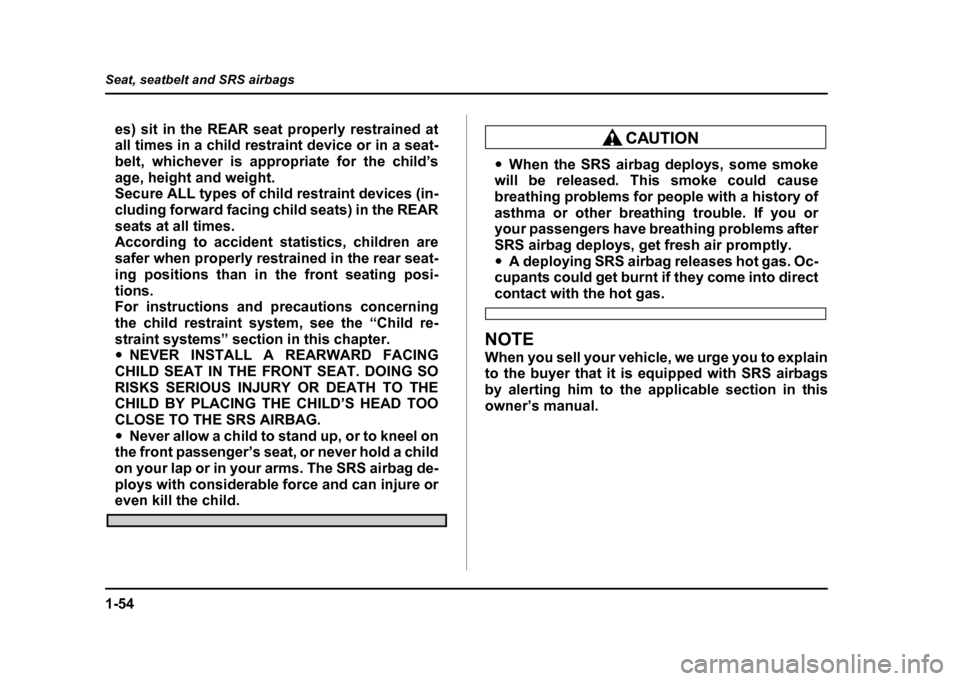
1-54
Seat, seatbelt and SRS airbags
es) sit in the REAR seat properly restrained at
all times in a child restraint device or in a seat-
belt, whichever is appropriate for the child’s
age, height and weight.
Secure ALL types of child restraint devices (in-
cluding forward facing child seats) in the REAR
seats at all times.
According to accident statistics, children are
safer when properly restrained in the rear seat-
ing positions than in the front seating posi-
tions.
For instructions and precautions concerning
the child restraint system, see the “Child re-
straint systems” section in this chapter. "
NEVER INSTALL A REARWARD FACING
CHILD SEAT IN THE FRONT SEAT. DOING SO RISKS SERIOUS INJURY OR DEATH TO THE
CHILD BY PLACING THE CHILD’S HEAD TOO
CLOSE TO THE SRS AIRBAG." Never allow a child to stand up, or to kneel on
the front passenger’s seat, or never hold a child
on your lap or in your arms. The SRS airbag de-
ploys with considerable force and can injure or
even kill the child.
" When the SRS airbag deploys, some smoke
will be released. This smoke could cause
breathing problems for people with a history of
asthma or other breathing trouble. If you or
your passengers have breathing problems after
SRS airbag deploys, get fresh air promptly." A deploying SRS airbag releases hot gas. Oc-
cupants could get burnt if they come into direct
contact with the hot gas.
NOTE
When you sell your vehicle, we urge you to explain
to the buyer that it is equipped with SRS airbags
by alerting him to the applicable section in this
owner’s manual.
Page 87 of 491
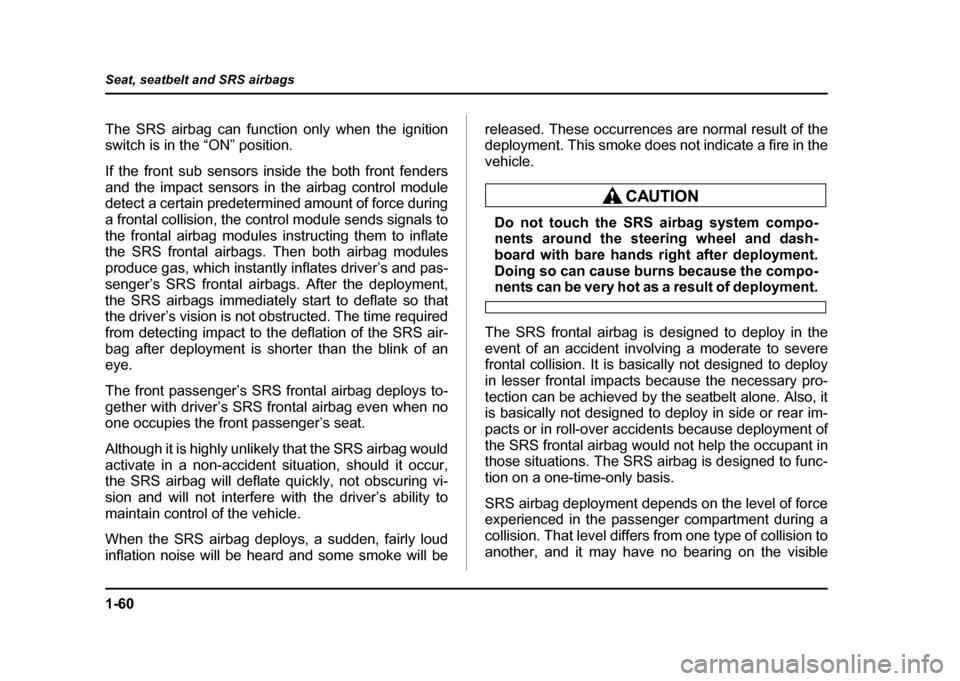
1-60
Seat, seatbelt and SRS airbags
The SRS airbag can function only when the ignition
switch is in the “ON” position.
If the front sub sensors inside the both front fenders
and the impact sensors in the airbag control module
detect a certain predetermined amount of force during
a frontal collision, the control module sends signals to
the frontal airbag modules instructing them to inflate
the SRS frontal airbags. Then both airbag modules
produce gas, which instantly inflates driver’s and pas-
senger’s SRS frontal airbags. After the deployment,
the SRS airbags immediately start to deflate so that
the driver’s vision is not obstructed. The time required
from detecting impact to the deflation of the SRS air-
bag after deployment is shorter than the blink of an eye.
The front passenger’s SRS frontal airbag deploys to-
gether with driver’s SRS frontal airbag even when no
one occupies the front passenger’s seat.
Although it is highly unlikely that the SRS airbag would
activate in a non-accident situation, should it occur,
the SRS airbag will deflate quickly, not obscuring vi-
sion and will not interfere with the driver’s ability to
maintain control of the vehicle.
When the SRS airbag deploys, a sudden, fairly loud
inflation noise will be heard and some smoke will be
released. These occurrences are normal result of the
deployment. This smoke does not indicate a fire in the vehicle.
Do not touch the SRS airbag system compo-
nents around the steering wheel and dash-
board with bare hands right after deployment.
Doing so can cause burns because the compo-
nents can be very hot as a result of deployment.
The SRS frontal airbag is designed to deploy in the
event of an accident involving a moderate to severe
frontal collision. It is basically not designed to deploy
in lesser frontal impacts because the necessary pro-
tection can be achieved by the seatbelt alone. Also, it
is basically not designed to deploy in side or rear im-
pacts or in roll-over accidents because deployment of
the SRS frontal airbag would not help the occupant in
those situations. The SRS airbag is designed to func-
tion on a one-time-only basis.
SRS airbag deployment depends on the level of force
experienced in the passenger compartment during a
collision. That level differs from one type of collision to
another, and it may have no bearing on the visible
Page 173 of 491
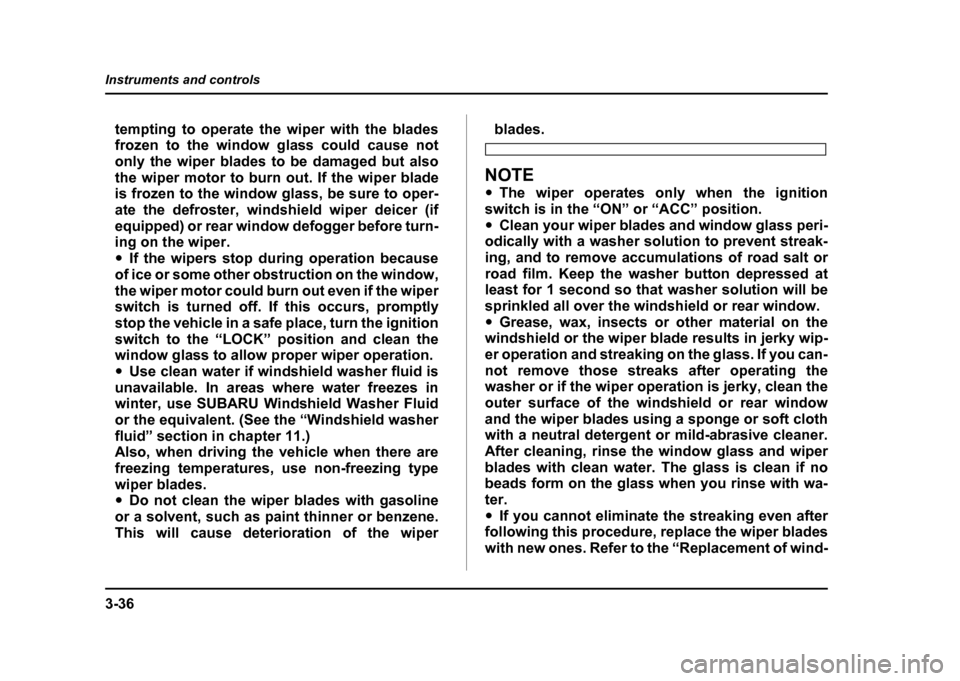
3-36
Instruments and controls
tempting to operate the wiper with the blades
frozen to the window glass could cause not
only the wiper blades to be damaged but also
the wiper motor to burn out. If the wiper blade is frozen to the window glass, be sure to oper-
ate the defroster, windshield wiper deicer (if
equipped) or rear window defogger before turn-
ing on the wiper. "
If the wipers stop during operation because
of ice or some other obstruction on the window,the wiper motor could burn out even if the wiper
switch is turned off. If this occurs, promptly
stop the vehicle in a safe place, turn the ignition
switch to the “LOCK” position and clean the
window glass to allow proper wiper operation. " Use clean water if windshield washer fluid is
unavailable. In areas where water freezes in
winter, use SUBARU Windshield Washer Fluid
or the equivalent. (See the “Windshield washer
fluid” section in chapter 11.)
Also, when driving the vehicle when there are
freezing temperatures, use non-freezing type
wiper blades. " Do not clean the wiper blades with gasoline
or a solvent, such as paint thinner or benzene.
This will cause deterioration of the wiperblades.
NOTE " The wiper operates only when the ignition
switch is in the “ON” or “ACC” position. " Clean your wiper blades and window glass peri-
odically with a washer solution to prevent streak-
ing, and to remove accumulations of road salt or
road film. Keep the washer button depressed at
least for 1 second so that washer solution will be
sprinkled all over the windshield or rear window." Grease, wax, insects or other material on the
windshield or the wiper blade results in jerky wip-
er operation and streaking on the glass. If you can-
not remove those streaks after operating the
washer or if the wiper operation is jerky, clean the
outer surface of the windshield or rear window
and the wiper blades using a sponge or soft cloth
with a neutral detergent or mild-abrasive cleaner.
After cleaning, rinse the window glass and wiper
blades with clean water. The glass is clean if no
beads form on the glass when you rinse with wa- ter. " If you cannot eliminate the streaking even after
following this procedure, replace the wiper blades
with new ones. Refer to the “Replacement of wind-
Page 408 of 491
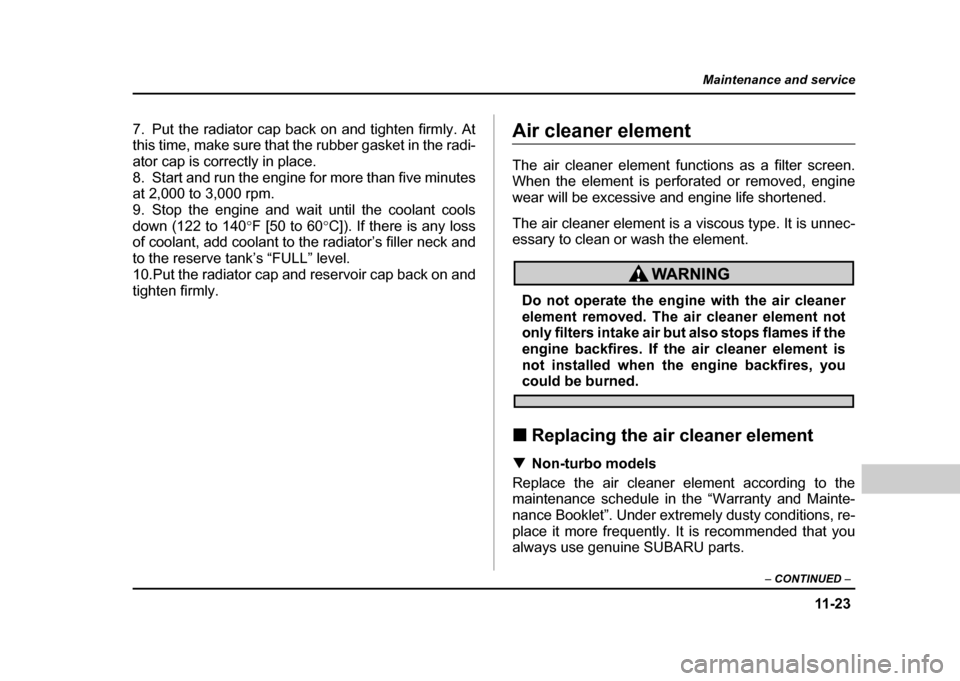
11 -2 3
Maintenance and service
– CONTINUED –
7. Put the radiator cap back on and tighten firmly. At
this time, make sure that the rubber gasket in the radi-
ator cap is correctly in place.
8. Start and run the engine for more than five minutes
at 2,000 to 3,000 rpm.
9. Stop the engine and wait until the coolant cools
down (122 to 140 °F [50 to 60 °C]). If there is any loss
of coolant, add coolant to the radiator’s filler neck and
to the reserve tank’s “FULL” level.
10.Put the radiator cap and reservoir cap back on and
tighten firmly.Air cleaner element
The air cleaner element functions as a filter screen.
When the element is perforated or removed, engine
wear will be excessive and engine life shortened.
The air cleaner element is a viscous type. It is unnec-
essary to clean or wash the element.
Do not operate the engine with the air cleaner
element removed. The air cleaner element not
only filters intake air but also stops flames if the
engine backfires. If the air cleaner element is
not installed when the engine backfires, you
could be burned.
! Replacing the air cleaner element
! Non-turbo models
Replace the air cleaner element according to the
maintenance schedule in the “Warranty and Mainte-
nance Booklet”. Under extremely dusty conditions, re-
place it more frequently. It is recommended that you
always use genuine SUBARU parts.
Page 468 of 491
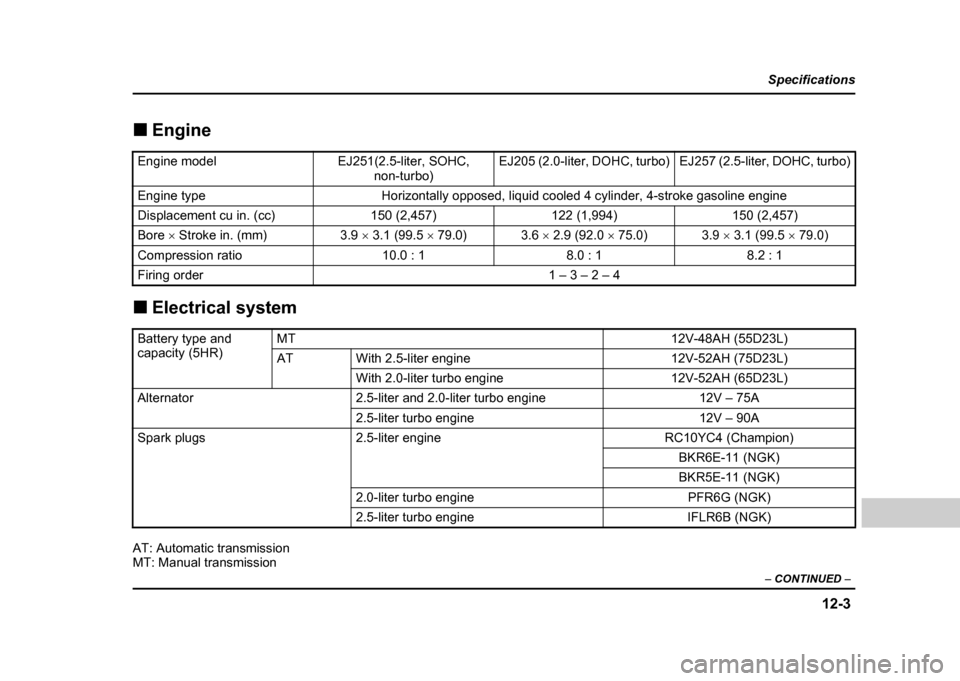
12-3
Specifications
– CONTINUED –
!Engine
! Electrical system
AT: Automatic transmission
MT: Manual transmission
Engine modelEJ251(2.5-liter, SOHC, non-turbo)EJ205 (2.0-liter, DOHC, turbo)EJ257 (2.5-liter, DOHC, turbo)
Engine typeHorizontally opposed, liquid cooled 4 cylinder, 4-stroke gasoline engine
Displacement cu in. (cc)150 (2,457)122 (1,994)150 (2,457)
Bore × Stroke in. (mm)3.9 × 3.1 (99.5 × 79.0)3.6 × 2.9 (92.0 × 75.0)3.9 × 3.1 (99.5 × 79.0)
Compression ratio10.0 : 18.0 : 18.2 : 1
Firing order1 – 3 – 2 – 4
Battery type and
capacity (5HR)MT12V-48AH (55D23L)
ATWith 2.5-liter engine12V-52AH (75D23L)
With 2.0-liter turbo engine12V-52AH (65D23L)
Alternator2.5-liter and 2.0-liter turbo engine12V – 75A
2.5-liter turbo engine12V – 90A
Spark plugs2.5-liter engineRC10YC4 (Champion)
BKR6E-11 (NGK)
BKR5E-11 (NGK)
2.0-liter turbo enginePFR6G (NGK)
2.5-liter turbo engineIFLR6B (NGK)